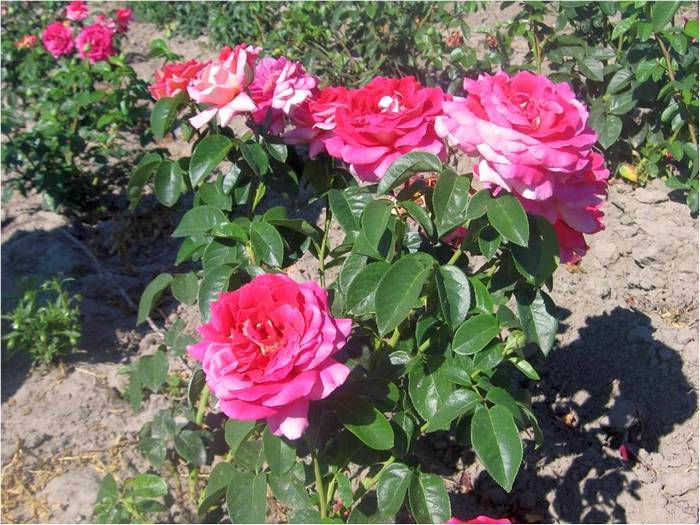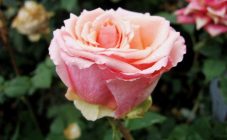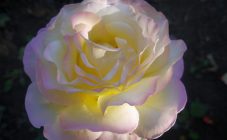Content:
Hybrid tea rose is the common name for varieties of the Modern garden roses group. This species owes its name to its origin - it originated from old tea roses, which had a rich aroma of freshly picked tea.
Since tea roses did not have good resistance to adverse weather conditions and were often sick, after many years of breeding work, hybrid tea varieties were bred, which, according to these indicators, significantly differ from their predecessors for the better.
Among the many independent species and hybrid forms, the Cronenburg hybrid tea variety is especially distinguished, which is part of the leading group of cut hybrids.
The history of the creation of the Kronenburg variety
Rose Kronenburg (lat.Rose Kronenbourg) is a vigorous remontant hybrid with large buds. It was bred in 1966 by breeder Samuel Mac Greedy, who used the Gloria Dei variety, also called Peace, to create it. That is why the unofficial name of the species is Flaming Peace.
Variety characteristics
Kronenbourg rose is a very vibrant re-flowering hybrid variety. The bushes of the hybrid are large enough, branched. The stems are tall - from 100 to 110 cm in height. The diameter of the plants is up to 1 m.
The flowers are large, double, and classic. The diameter of the blossoming flower is 10-13cm. On the peduncles, they are located singly.
The buds of Kronenbourg have a two-tone color - they are painted in bright red tones on the outside, while on the inside their petals are creamy yellow. However, the yellow color is almost invisible due to the shape of the buds.
The flowering of the variety is uniform and long - in central Russia, it blooms from late June to the first frost.
The aroma of flowers is pleasant and unobtrusive, with pronounced raspberry notes.
The resistance to diseases in the Cronenburg species is average, it often gets sick in unfavorable years, which is why it is recommended to periodically treat the bushes with fungicides as a preventive measure. The most common pests of the variety are aphids, scale insects, leafworms, rose sawfly, thrips and rose cicadas, against which ordinary insecticides are effectively used.
In the description of the Cronenburg rose variety, it is indicated that the plant is highly winter-hardy and can withstand frosts down to −23 ° C, but gardeners' reviews on this matter are mixed.
Agrotechnics
Without exception, all varieties of hybrid tea roses need careful care. This is a rather capricious heat-loving shrub, demanding on watering and soil type. In addition, despite the declared level of cold resistance, the plant should be well covered for the winter so that the flower does not freeze.
The description of the rules for planting and leaving the Cronenburg rose will allow flower growers to choose the most favorable conditions for a flower.
Illumination requirements
Cronenburg roses need good lighting and protection from the wind, so it is not recommended to plant this variety in the shade of trees, against a wall or in a lowland, since such conditions contribute to the development of diseases and decay of the bushes.However, this does not mean that the bush should be planted directly under the open sun - the area where the flower will grow should receive sunlight and shading in equal proportions.
Soil requirements
When choosing a place for planting a plant, you should focus on dry elevated areas, since with excessive soil moisture, spots appear on the leaves and stems of roses. Best of all, the Cronenburg hybrid grows on sandy-clay soils of weak acidity - roses prefer slightly acidic soil (ph 5.5-6.5).
Landing
The optimal time for planting Cronenburg roses in the ground is April-May. It is recommended to plant this variety after the soil temperature reaches 10-12 ° C, and it is advisable to choose seedlings with not yet blossoming buds or with very short shoots.
General landing rules:
- The depth of the planting holes should be at least 40 cm. The width is 40-60 cm. On heavy clay soil, the hole is made deeper (60-70 cm).
- The bottom of the pit is covered with humus or compost with the addition of wood ash.
- A mound of fertile soil is poured over the fertilizer layer, on which the seedling is then installed.
- The roots of the seedling are straightened, evenly distributed over the mound, and then sprinkled with earth. In this case, the vaccination site is deepened by 5-7 cm.
- The final stage of planting is mulching the planting with compost, humus or dry soil. Then the planted bush should be shaded for 10-12 days.
Watering
The plant is quite drought-resistant, but during especially hot months it must be watered. For dry areas, drip irrigation is recommended. If the bushes are watered by hand, use up to 20 liters of water per m2.
Top dressing
The fertilization procedure is carried out twice a year. In the middle of spring, fertilizing with nitrogen content is applied. In summer, the bushes are fed with potash and phosphorus fertilizers.
Preparing for winter
For the winter, hybrid tea roses require careful shelter with good ventilation so that the bush does not fall out. For this, the plants are covered with sand or dry soil to a height of 30 cm and covered with spruce branches.
With the onset of spring, roses open. They do this in the evening so that the young shoots are burned by the sunbeam.
Pruning
In the spring, the bushes must be pruned. It is recommended to leave small shoots - on average, their length should not exceed more than 20 cm from the ground.
Pruning during the fall months involves removing dried or damaged shoots.
Advantages and disadvantages of the variety in comparison with other varieties
Cronenberg rose has the following benefits:
- good stability - the buds are practically not damaged by rain;
- medium resistance to disease: on the one hand, the plant is quite resistant to black spot and powdery mildew, but it often gets sick in unfavorable years, and is also easily affected by aphids and spider mites;
- high frost resistance;
- medium drought tolerance;
- pleasant unobtrusive aroma;
- unusual color of buds.
There are no pronounced shortcomings in the Cronenberg species, except for the demand for care.
The bizarre combination of two warm, vibrant shades sets this variety apart from most other two-tone hybrids. Rose Kronenbourg is used both in single plantings in a flower bed and in the creation of flower arrangements and rose gardens. Long, straight stems with large flowers also work well when cut.


















